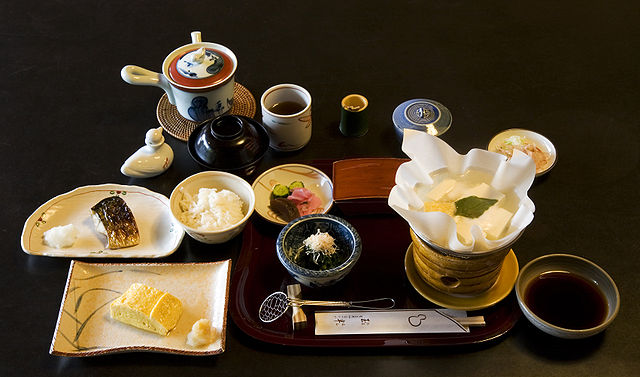Ramen is a Japanese noodle dish of Chinese origin. It consists of Chinese-style wheat noodles served in a broth; common flavors are soy sauce and miso, with typical toppings including sliced pork , nori, menma, and scallions. Ramen has its roots in Chinese noodle dishes and is a part of Japanese Chinese cuisine. Nearly every region in Japan has its own variation of ramen, such as the tonkotsu ramen of Kyushu and the miso ramen of Hokkaido.
Shōyu ramen
From Seiichi Yoshida, How to Prepare Delicious and Economical Chinese Dishes (1928).
Rairaiken (来々軒), the first ramen shop, founded in 1910 by Kan'ichi Ozaki in Asakusa, Tokyo. The signs advertise "Chinese soba" (支那蕎麥) and "Guangdong cuisine" (廣東料理).
A bowl of ramen from the second Rairaiken in Yūtenji, opened in 1933 by Fu Xinglei (傅興雷), one of the twelve Chinese cooks from the first Rairaiken store in Asakusa
Japanese cuisine encompasses the regional and traditional foods of Japan, which have developed through centuries of political, economic, and social changes. The traditional cuisine of Japan is based on rice with miso soup and other dishes with an emphasis on seasonal ingredients. Side dishes often consist of fish, pickled vegetables, and vegetables cooked in broth. Common seafood is often grilled, but it is also sometimes served raw as sashimi or as sushi. Seafood and vegetables are also deep-fried in a light batter, as tempura. Apart from rice, a staple includes noodles, such as soba and udon. Japan also has many simmered dishes, such as fish products in broth called oden, or beef in sukiyaki and nikujaga.
Osechi, new year special dishes
Osechi, new year dishes
A Japanese meal including tempura, sashimi, and miso soup
Breakfast at a ryokan (Japanese inn), featuring grilled mackerel, Kansai-style dashimaki egg, tofu in kaminabe (paper pot)








